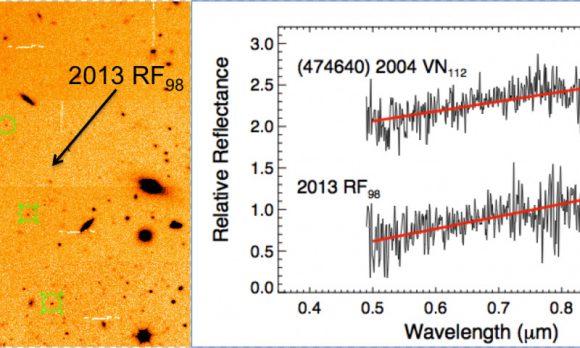Last year, Caltech astronomers Mike Brown and Konstantin Batygin found indirect evidence for the existence of a large planet in the outer reaches of our Solar System -- likely located out past Pluto -- and since then, the search has been on. The latest research continues to show signs of an unseen planet, the hypothetical Planet 9.
Astronomers using the Gran Telescopio CANARIAS (GTC) in the Canary Islands looked at two distant asteroids called Extreme Trans Neptunian Objects' (ETNOs), and spectroscopic observations show and their present-day orbits could be the result of a past interaction with a large "superearth"-type object orbiting the Sun at a distance between 300 to 600 AU.
Researchers say the orbits of asteroids 2004 VN112 and 2013 RF98 suggest that the two were once a binary asteroid which separated after an encounter a large body, with a mass of between 10 and 20 Earth masses.
"The similar spectral gradients observed for the pair 2004 VN112 - 2013 RF98 suggests a common physical origin," said Julia de León, the first author of a new paper, and who is an astrophysicist at the Instituto de Astrofísica de Canarias (IAC). "We are proposing the possibility that they were previously a binary asteroid which became unbound during an encounter with a more massive object."

Sequence of images taken with the Gran Telescopio CANARIAS (GTC) to identify one of the ETNO´s studied in this article, 2013 RF98, where one can see how it moves during four consecutive nights. Below, right, visible spectra obtained with the GTC of the two objects 2004 VN112 and 2013 RF98. The red lines show the gradients of the spectra. Credit: Julia de León (IAC).
To test their hypothesis, the team performed thousands of simulations to see how the poles of the orbits would separate as time went on. The results of these simulations suggest that a possible Planet 9 could have separated the pair of asteroids around 5 and 10 million years ago.
de León said this could explain, in principle, how these two asteroids, starting as a pair orbiting one another, became gradually separated in their orbits after an encounter with a much more massive object at a particular moment in time.
The tale of Planet 9 started in 2014, when astronomers Chad Trujillo and Scott Shepard were studying the motions of large objects in the Kuiper Belt and realized that a large planet in the outer Solar System must be altering orbits of several ETNOs the in Kuiper Belt.
Brown and Batygin were looking to verify or refute the research of Trujillo and Shepard, and they painstakingly analyzed the movement of various KBOs. They found that six different objects all seem to follow a very similar elliptical orbit that points back to the same region in space.
All the bodies were found to be inclined at a plane of about 30-degrees different from almost everything else in the Solar System. Brown said the odds of these orbits all occurring randomly are about 1 in 100.
But calculations revealed the orbits could be influenced by a massive planet way out beyond the orbit of Pluto, about 200 times further than the distance from the Sun to the Earth. This planet would be Neptune-sized, roughly 10 times more massive than Earth.
It hasn't been found yet, but the hunt is on by large telescopes around the world, and a new citizen science project allows people around the world to join in the search.
The latest findings of by de León and team could help point the way to where Planet 9 might be lurking.
Source: PhysOrg
No comments:
Post a Comment